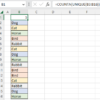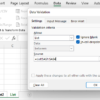COUNT Function. Number of numbers.(Microsoft Excel)
The COUNT function obtains the number of numeric values in a specified cell range.
How it works
=COUNT(value1 to 255)
| Name | Omission | Description |
|---|---|---|
| value1 to 255 | Required argument. | Cell range in which to count numbers. |
Demonstrate
If non-numeric data are mixed in, they are ignored and counted.
Numbers treated as characters are also ignored.
Blanks, Boolean values, and errors are not included in the count.
Unlike the SUM function, the COUNT function does not error if errors are introduced.

If you want to count non-numeric numbers, use the COUNTA function.
The COUNTA function is probably used more often than the COUNT function.
Specify other than cell range.
It is also possible to have a function argument that returns a range of cells as a result. In that case, it will be the number of results of the function.
List of functions that result in a range of cells.
| Function | Category | Description |
|---|---|---|
| TEXTSPLIT | Text | Divides text into cells based on a specified character. |
| XLOOKUP | Lookup & Reference | Get data matching the search value. |
| FILTER | Lookup & Reference | Get a list of data that matches the condition. |
| UNIQUE | Lookup & Reference | Delete duplicate data in a specified cell range. |
| SEQUENCE | Lookup & Reference | Create sequential numbers in multiple cells. |
| SORT | Lookup & Reference | Sort a range of cells by a specified column. |
| SORTBY | Lookup & Reference | Sort a cell range by specifying multiple reference columns. |
| DROP | Lookup & Reference | elete a specified number of rows and columns from a specified cell range. |
| TAKE | Lookup & Reference | Obtains a specified number of rows and columns from a specified cell range. |
| TOCOL | Lookup & Reference | Arranges a specified range of cells in a single column. |
| TOROW | Lookup & Reference | Sort a specified range of cells into a single column. |
| EXPAND | Lookup & Reference | Extended specified cell range. |
| CHOOSEROWS | Lookup & Reference | Get the row at the specified position from the specified cell range. |
| CHOOSECOLS | Lookup & Reference | Get the column at the specified position from the specified cell range. |
| WRAPROWS | Lookup & Reference | Sort a range of cells in a single column or row by a specified number of rows. |
| WRAPCOLS | Lookup & Reference | Sort a range of cells in a column or row by a specified number of columns. |
| VSTACK | Lookup & Reference | Merge multiple cell ranges in row direction. |
| HSTACK | Lookup & Reference | Merge multiple cell ranges in column direction. |
| TRANSPOSE | Lookup & Reference | Create a cell range with the rows and columns of the specified cell range swapped. |

The range can also be specified as an array.
=COUNT({10,1,2,5})

Multiple values can also be specified simply by separating them with commas.
=COUNT(10,1,2,5)

Spill
Spill when using the BYROW or BYCOL function.
=BYROW(A1:E5,LAMBDA(r,COUNT(r)))

=BYCOL(A1:E5,LAMBDA(c,COUNT(c)))

Links
Count of multiple values or cell ranges.
| Function | Importance | Description |
|---|---|---|
| COUNT | High | Count of multiple values or cell ranges. |
| COUNTA | High | Get the number of non-blanks. |
| COUNTBLANK | Middle | Get the number of blanks. |
| COUNTIF | Middle | Get the number of cells matching the search criteria. |
| COUNTIFS | High | Get the number of rows that match multiple criteria. |


Discussion
New Comments
No comments yet. Be the first one!